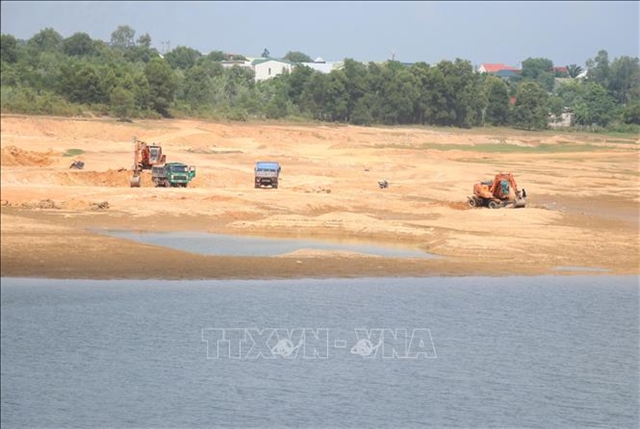 Society
Society


|
| An area for dumping dredged materials in Quảng Trị Province. VNA/VNS Photo |
QUẢNG TRỊ – The People's Committee of Quảng Trị has just approved 720ha of sea area for sinking dredged materials.
The decision clearly states that Area No 1 in Gio Linh District has an area of 320ha, limited by corner points QT1-1, QT1-2, QT1-3, QT1-4, depth from 25 - 30m from level "0" of the national elevation system; while Area No 2 in Hải Lăng District has an area of 400ha, limited by corner points QT2-1, QT2-2, QT2-3, QT2-4 and depth from 22 - 25m.
In terms of scale, Area No 1 has a capacity of 2.4 million cu.m and Area No 2 can contain 3 million cu. m.
The maximum volume submerged in one day is 11,500 cu.m and 14,400 cu.m for area No 1 and No 2, respectively.
Dredged material transport equipment has a maximum tonnage of about 2,000 tonnes and the most suitable time to carry out submersion is from April to August.
In case the total volume of dredged material for dumping in the two areas exceeds the designed capacities, or dredged material transport equipment has a tonnage of over 2,000 tonnes, it is necessary to study in more detail the extent of diffusion of submerged material and change in the bottom topography of the areas to have suitable solutions to protect the environment and biodiversity in the area, as well as surrounding areas.
Regarding implementation, the provincial Department of Natural Resources and Environment is responsible for announcing the areas of sinking dredged material in the sea under the management of Quảng Trị Province, and appraise and submit to the provincial People's Committee to issue, reissue, extend, amend, supplement and return sea dumping permits under the authority of the provincial People's Committee.
Annually, the department also has to develop plans and carry out environmental monitoring and supervision in marine areas to sink dredged materials according to assigned tasks.
After five years, the department will conduct a survey and re-assess the environment, biodiversity, dispersal and spread of materials in the ocean dumping area to serve as a basis for advising the provincial People's Committee in granting dumping permits for future projects.
The State management agencies and sectors are responsible for organising inspection and supervision of dumping activities and handling violations according to the provisions of law.
Organisations and individuals who have need to dump dredged materials in the above areas must fully carry out procedures to apply for sea dumping permits in accordance with regulations and can only dump dredged materials when granted permits by the State management agencies.
In addition, organisations and individuals must strictly comply with relevant legal regulations when dumping dredged materials at sea, such as using the right locations, only dumping the types of dredged materials and volumes as permitted by competent authorities, as well as taking responsibilities for any incidents or violations of law in dredging and dumping activities according to the provisions of law.
Hà Sỹ Đồng, vice chairman of the Quảng Trị People’s Committee, said that previously, the province did not have a plan designating specific marine areas to sink dredged materials, which made it difficult to manage, control and minimise pollution impacts caused by dredging and dumping of waste into the environment, ecosystems and marine protected areas.
Therefore, approving areas for dumping dredged materials in the sea is very practical, ensuring strict control, said Đồng.
Dumping dredged materials at sea is the intentional sinking into the sea of objects and substances according to legal regulations.
According to the Law on Sea and Islands Resources and Environment, objects and substances sunk in the sea must meet the following conditions of not containing radioactive substances or toxins that exceed technical regulations on radiation safety regulations and environmental technical standards; being processed to meet environmental technical standards; ensuring no harmful effects on human health, environment, ecosystems and aquatic resources; and being unable to be dumped, stored or treated on land, or the dumping, storage or treatment on land not being socio-economically effective.
According to Article 60 of Decree 40/2016/NĐ-CP, the list of objects and substances allowed to be dumped at sea is regulated to include: dredged substances, sludge, waste from seafood or waste generated from seafood processing activities, boats, floating platforms or artificial structures at sea, inert geological substances and inorganic substances, organic substances of natural origin, large objects made up mainly of iron, steel, concrete or similar non-toxic substances that, under specific conditions and circumstances, have no better treatment than submersion, and carbon dioxide (CO2) that is captured and stored. VNS